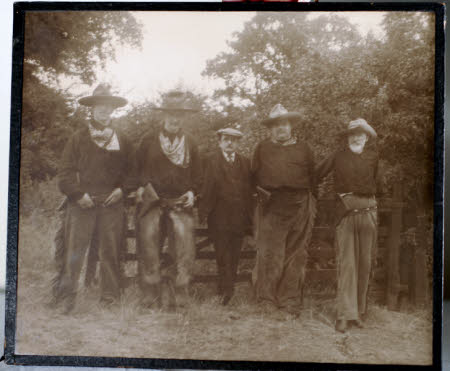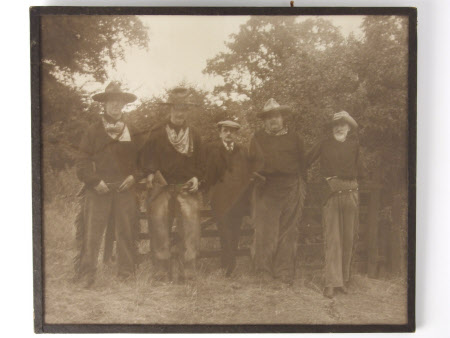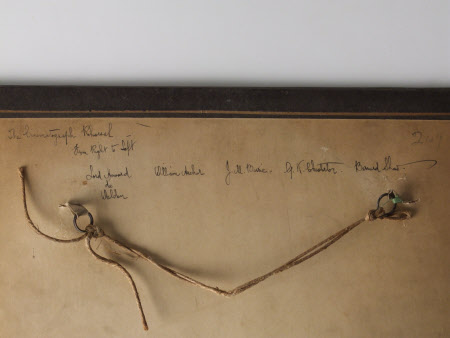Making the cowboy film “How Men Love”: Lord Howard de Walden, William Archer, J.M. Barrie, G.K. Chesterton and Bernard Shaw
Harley Granville-Barker (1877-1946)
Category
Photographs
Date
1914
Materials
Paper
Measurements
10.25 ins (h)12.125 ins (w)
Order this imageCollection
Shaw's Corner, Hertfordshire
NT 1274695
Summary
A photograph of 5 men (4 dressed as cowboys) by Harley Granville-Barker (1877-1946). From left to right: the philanthropist Lord Howard de Walden, the drama critic William Archer, novelist J.M. Barrie, writer G.K. Chesterton, and Bernard Shaw. 1914. The photograph was taken during the making of a comedy “Cowboy” film in 1914 by Barrie, a silent burlesque of a “Western”. The film was later given the title “How Men Love”. (Ian Ker, G.K. Chesterton: A Biography, 2011, Oxford University Press, p.350). According to Chesterton, the film was shot in Essex, with Barker as director. Black passe-partout, glazed.
Full description
A photograph of 5 men (4 dressed as cowboys) by Harley Granville-Barker (1877-1946). From left to right: the philanthropist Lord Howard de Walden, the drama critic William Archer, novelist J.M. Barrie, writer G.K. Chesterton, and Bernard Shaw. 1914. The photograph was taken during the making of a comedy “Cowboy” film in 1914 by Barrie, a silent burlesque of a “Western”. The film was later given the title “How Men Love”. (Ian Ker, G.K. Chesterton: A Biography, 2011, Oxford University Press, p.350). According to Chesterton, the film was shot in Essex, with Barker as director. The novelist and dramatist J.M. Barrie, who was a neighbour of the Shaws at Adelphi Terrace (their London flat) had been exploring the relationship between the stage and film, and envisaged the “Cowboy” film as a feature to show alongside humorous footage taken secretly at a “Cinema Supper” given at the Savoy in London in 1914 (again starring Shaw, Archer, Chesterton, and Howard de Walden). Chesterton recorded details of the filming of the cowboys scene: “We went down to the waste land in Essex and found our Wild West equipment. But considerable indignation was felt against William Archer; who, with true Scottish foresight, arrived there first and put on the best pair of trousers … We were rolled in barrels, roped over fake precipices and eventually turned loose in a field to lasso wild ponies, which were so tame that they ran after us instead of our running after them, and nosed in our pockets for pieces of sugar.” (quoted in Ian Ker, G.K. Chesterton: A Biography, 2011, p.350). Although guests at the Savoy dinner refused to allow the footage from that night to be used, two years later Barrie included the “Cowboys” film in a charity event in aid of the War Hospital held at the Coliseum in London on 9 June 1916. On this occasion it was given the title “How Men Love”. Mrs Patrick Campbell wrote to Shaw about it in 1916, informing him that she was taking part in the charity event: “tomorrow an introduction before a movie of yourself rolling down a hill in a barrel to be spoken by me at the Coliseum.” (Mrs Patrick Campbell to Shaw, 8 June 1916, in Bernard Shaw and Mrs Patrick Campbell: Their Correspondence, 1952, p.188). It is possible that Barrie also used the "cowboy" footage in a revue, "Rosy Rapture", that he wrote for Gaby Deslys. The film was known to exist in 1941 but has since been lost. Other copies of the photograph can be found in the British Library (Add MS 50582, f.39); and in the Shaw Photographic Collection (NT 1715227.34). (Alice McEwan, 2020)
Provenance
The Shaw Collection. The house and contents were bequeathed to the National Trust by George Bernard Shaw in 1950, together with Shaw's photographic archive.
Marks and inscriptions
On backboard in GBS handwritting -"The Cinematograph Rehearsal / From Right to Left / Lord howard de Walden William Archer J.M.Barrie. G.K.Chesterton. Bernard Shaw." (Order left to right as seen from front.)
Makers and roles
Harley Granville-Barker (1877-1946), photographer
References
National Book League (Great Britain), Bernard Shaw:, 1946?, p.43 Bernard Shaw through the camera : 1948., p.95


